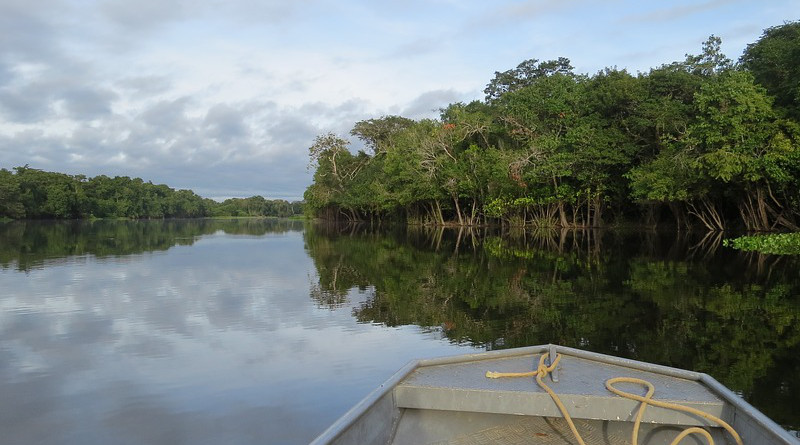When Indigenous Communities Have Legal Land Rights, This Brazilian Forest Benefits
A University of Colorado Boulder-led study shows that between 1985 and 2019 in Brazil’s Atlantic Forest, deforestation decreased and reforestation increased on lands where Indigenous communities had been able to complete a legal process to receive formal recognition of their ancestral lands.
Indigenous communities in Brazil’s Atlantic Forest who attain full, formal recognition of their land rights reduce deforestation and increase forest cover, finds a new University of Colorado Boulder-led study.
Published in PNAS Nexus, the paper supports ongoing research around the world showing that legally recognizing Indigenous peoples’ land rights can help lessen land grabs and human rights violations, as well as mitigate climate change and biodiversity loss.
The study shows that between 1985 and 2019, reducing deforestation and increasing reforestation in Brazil’s Atlantic Forest was more successful in Indigenous communities who had completed a legal process to receive formal recognition of their ancestral lands, known as land tenure, than those who had not been granted land tenure.
“Our study adds an important piece to the growing body of evidence that tenure in Indigenous lands has often improved forest outcomes—including now in the Atlantic Forest, which has experienced high deforestation pressures over a long period of time,” said Rayna Benzeev, lead author of the study, who carried out her research while a doctoral student in the Department of Environmental Studies.
The study is also some of the first research to examine the impacts of land tenure for Indigenous territories in the Atlantic Forest—a vulnerable, fragmented rainforest on the eastern coast of Brazil, which has faced intense development pressures such as agriculture, urbanization, mining and logging.
“Protecting forests is not only important for the trees and the biodiversity. It’s also critical for the people that live within them and depend on them—and accounting for humans is an integral part of the sustainable future of forests,” said Peter Newton, co-author of the study and associate professor in the Department of Environmental Studies.
Brazilian forest conservation
The Atlantic Forest, Brazil’s second largest rainforest, covers around 34,750 square miles and spans 1,865 miles of the Atlantic Coast—including 17 states of Brazil and several large urban centers, such as Rio de Janeiro and São Paulo. After five centuries of deforestation, much of the 11.7% of original forest that remains is found in rural communities and on Indigenous lands. In comparison, the well-known Amazon rainforest still retains 80% of its original forest area.
Previous research has established the importance of Indigenous land rights in forest conservation efforts, especially in the Amazon rainforest. But the new research fills an important gap for the Atlantic Forest, which is more heavily deforested and developed.
“The Atlantic Forest is an extremely important tropical forest biome with a lot of potential for reforestation. It has also been largely overlooked from an international standpoint even though it is in some ways more threatened than the Amazon,” said Benzeev, now a postdoctoral researcher at University of California Berkeley.
The new study also provides support for additional political moves that could be made by Brazilian President Luiz Inácio Lula da Silva, or Lula, said Benzeev.
In his first weeks in office, da Silva issued six decrees that revoke or alter measures implemented by his predecessor Jair Bolsonaro, which were broadly considered to be anti-environment and anti-Indigenous. Da Silva also established the Ministry of Indigenous Peoples, an unprecedented act in Brazil’s history.
Many Indigenous peoples in forested areas around the world, whether it’s in Brazil, or Indonesia, Central Africa or elsewhere, have long had customary rights to their ancestral lands, according to Newton.
“But there can be a significant difference between that and having legal rights over the same area of forest,” he said.
Diving into the data
Benzeev and her co-authors conducted several different analyses, using publicly available government-sourced data for 129 Indigenous communities in the Atlantic Forest who had completed or had started the land tenure process between 1985 and 2019. Of those communities, 77 completed the land tenure process and 52 were still in process, which the researchers called “incomplete tenure.”
In addition, they used data from high quality satellite imagery from 1985 to 2019, which illustrates both reforestation and deforestation. While forest cover change alone does not indicate levels of biodiversity or forest health, it is a useful metric for evaluating land use dynamics over large spatial scales, according to Newton.
The researchers found less deforestation and/or increased reforestation on lands where Indigenous peoples had completed the four-part land tenure process and had been granted formal tenure rights, in marked contrast to Indigenous territories where communities had no legal rights or were still part way through the process of being granted formal tenure.
“Our paper shows that each year after tenure was formalized there was a 0.77% increase in forest cover, compared to untenured lands, on average—which can add up over decades,” said Benzeev.
She was surprised, however, to find that communities who made it only to the third of four stages of the land tenure process saw no significant decreases in deforestation and/or increases in forest restoration—highlighting that completing all four stages of the land tenure process was necessary to see the desired positive environmental outcomes.
The land tenure process is guaranteed by the Brazilian Constitution created in 1988. However, the lengthy process has stalled in the past decade for hundreds of Indigenous communities. Since 2012, only one Indigenous community in the study sample had successfully been granted legal land rights—the last step in the tenure process.
“Much of the stagnation in the land tenure process has taken place in recent years and mainly for political reasons,” said Benzeev. “This is exactly what makes the legal component of tenure important: when tenure is legally granted, Indigenous peoples are able to gain territorial autonomy irrespective of political shifts over time.”

